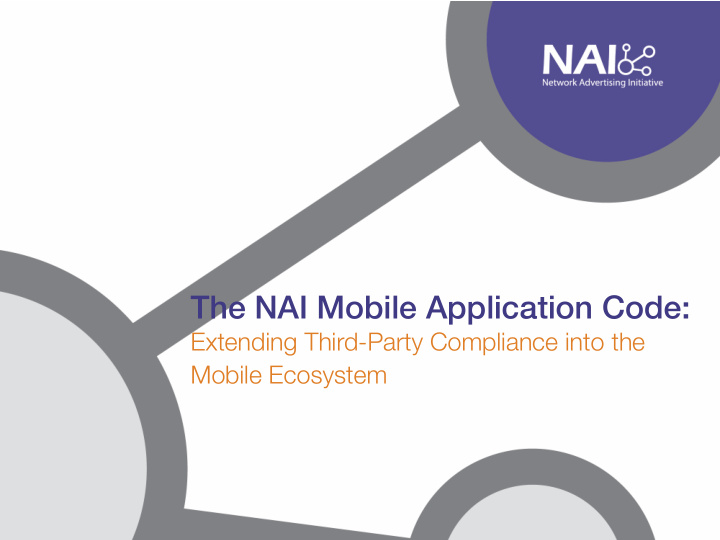



The NAI Mobile Application Code: Extending Third-Party Compliance into the Mobile Ecosystem
Why a Mobile Application Code? • Extend the NAI compliance program into the mobile application space • Provide extra flexibility for this rapidly developing ecosystem • Help members develop business models, procedures, and technologies that provide consumers with adequate notice and choice
Scope • Governs only NAI member companies • Does not cover all data collection by members, but is limited to Cross-App Advertising and Ad Delivery and Reporting • Advertising data collected across unaffiliated websites in mobile browsers will be covered by the 2013 NAI Code of Conduct, with mobile-specific guidance as necessary • Applies only to activities that (1) occur in the United States or (2) apply to U.S. users
Member Obligations • Education • Notice & Transparency • Choice/User Control • Use Limitations • Transfer Restrictions • Access • Reliable Sources • Data Security & Retention • Accountability
General Framework • The Code identifies three broad categories of data: 1. Personally Identifiable Information (PII) 2. Non-PII 3. De-Identified Data • The Code also imposes special obligations on: 1. Sensitive Data 2. Precise Location Data; and 3. Personal Directory Data
Three Types of Notice Website Notice: • Describes data collection, use, and transfer for CAA & ADR • Describes or provides access to an opt-out mechanism
Three Types of Notice App Store Notice: • Posted in any store or on any website where the app may be acquired • Must be included in contractual agreements with individual app providers, if such contracts exist
Three Types of Notice Enhanced Notice: • Notice in or around ads informed by Cross-App Data or • In the app settings and at download or first use.
Health Transparency • Members that use standard interest segments based on health-related data must disclose those segments on their websites. • Health-related data is anything related to the body, including: • Health & wellness; • Diet & fitness; • Migraines • Etc.
User Control for Cross-App Advertising • Use of Non-PII for CAA requires access to an Opt-Out Mechanism. • Prospective merger requires access to an Opt-Out Mechanism and robust notice. • Retrospective merger and use of Sensitive or Precise Location Data requires Opt-In Consent. • May not access a device to obtain Personal Directory Data without user authorization.
Opt-Out Mechanism • No industry-wide mechanism (yet) • Code requires that any Opt-Out Mechanism be: (1) reasonably easy to use and (2) durable. • Platform-provided tools (like iOS’s Limit Ad Tracking feature) may meet this requirement. • Individual member mechanisms will be evaluated during pre-certification.
Use Limitations • Members may not create Cross-App Advertising segments targeting children under 13 without obtaining verifiable parental consent. • Members may not use or allow the use of Cross- App or ADR data for: 1. Employment Eligibility 2. Credit Eligibility 3. Health Care Eligibility 4. Insurance Eligibility and Underwriting and Pricing • Material changes require Opt-In Consent
Transfer Restrictions • When transferring PII to an unaffiliated party for Cross-App Advertising or Ad Delivery & Reporting, must contractually require that the unaffiliated party will adhere to the applicable provisions of the code. • When transferring Non-PII collected across applications, the unaffiliated entity must not attempt to merge that Non-PII with PII or attempt to re-identify the individual. This does not apply if the Non-PII is proprietary to the receiving party.
Data Access, Quality, Security & Retention Members must: • Provide reasonable access to PII; • Conduct due diligence to ensure the obtain Cross- App Data from reliable sources (notice & choice); • Provide reasonable security for ad data; and • Only hold data as long as necessary to fulfill a legitimate business need, or as required by law.
Accountability • Members must represent that their business practices are in compliance with the NAI Mobile Application Code. • Members are required to undergo annual compliance reviews. The aggregate results of the annual compliance process are published. • Members must provide a mechanism to receive consumer complaints and inquiries and make reasonable efforts to timely respond to concerns regarding compliance with the NAI Code.
DIFFERENCES BETWEEN THE NAI & DAA MOBILE CODES
Di ff erence between DAA & NAI Codes • NAI always requires notice on member website. • NAI notice requires: • A general description of the technologies used for data collection; • Data retention practices/limits; or • Standard interest segments based on health- related information. • NAI requires app store notice. • NAI distinguishes between PII and Non-PII.
Q&A
Recommend
More recommend